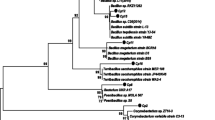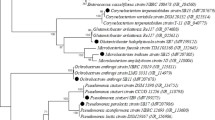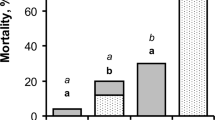Abstract
Wohlfahrtia magnifica (Diptera: Sarcophagidae) is the major myiasis-causing fly species in the whole of Eurasia for most important domestic animals. The aim of the present work was to obtain data on the culturable bacteria isolated under aerobic conditions from this fly: bacteria were isolated from all developmental stages (larvae, pupa, and imago) of Wohlfahrtia magnifica, and the third-stage larval organs were also sampled. To determine the possible antagonistic effects between the dominant bacterial groups, an antibiosis assay was carried out. Plating and isolation of bacteria was performed by classical microbiological methods. Characterization of the isolated strains was carried out via a polyphasic approach; classical phenotypic tests, chemotaxonomical examinations, and 16S rDNA sequence analyses were also applied. In the case of maggot macerate samples, members of the family Enterobacteriaceae were characteristic. Members of a new genus (Schineria) belonging to the γ subdivision of proteobacteria were also isolated. According to our data, the shifts in the Schineria and Proteus populations within the larvae are strongly influenced by their interactions with each other and among the members of the family Enterobacteriaceae. The pupa and imago samples contained several other Gram-negative bacteria (Stenotrophomonas, Brevundimonas, etc.). Among Gram-positive bacteria, in all maggot macerate samples, members of the genus Bacillus and the Arthrobacter–Micrococcus group of actinobacteria were dominant (neither of them was a producer or sensitive to the compounds of other microorganisms), and bacteria related to the genus Corynebacterium were also found. From the larvae Aureobacterium liquefaciens and Enterococcus faecalis were isolated, and from the pupae Dietzia maris and Enterococcus faecalis. In the samples of third-stage larval organs, the dominant groups were the same as in the third-stage larval macerate sample; however, several additional genera/species were observed (Rhodococcus fascians, Streptomyces sp., Rathayibacter sp., Bacillus thuringiensis/cereus).



Similar content being viewed by others
References
H Ishikawa (1989) A synthesis: the types of interaction system between bacteria and insects V Nardon AM Gianinazzi-Pearson L Margulis DC Smith (Eds) Endocytobiology 4 INRA Paris 355–361
B Groombridge (1992) Global biodiversity F Chapman M Hall (Eds) Status of Earth's Living Resources Academic Press London 69–73
AE Cazamier JHP Hackstein HJM Camp ParticleOp den J Rosenberg C Drift ParticleVan der (1997) ArticleTitleBacteria in the intestinal tract of different species of Arthropods Microb Ecol 33 189–197
MJR Hall R Farkas (2000) Traumatic myiasis of humans and animals L Papp B Darvas (Eds) Contributions to a Manual of Palearctic Diptera Science Herald Budapest 751–768
I Ruiz-Martinez MD Soler-Cruz R Benitez-Rodriguez S Munoz-Parra M Diaz-Lopez A Florido-Navio (1987) ArticleTitleMyiasis caused byWohlfahrtia magnifica in Southern Spain Isr J Vet Med 43 34–41
MJR Hall R Wall (1995) ArticleTitleMyiasis of humans and domestic animals Adv Parasitol 35 257–337 Occurrence Handle1:STN:280:DyaK2M3isFaisg%3D%3D Occurrence Handle7709854 Occurrence Handle10.1016/S0065-308X(08)60073-1
R Farkas MJR Hall F Kelemen (1997) ArticleTitleWound myiasis of sheep in Hungary Vet Parasitol 69 133–144 Occurrence Handle1:STN:280:DyaK2szjtVGkuw%3D%3D Occurrence Handle9187038
R Farkas MJR Hall (1998) ArticleTitlePrevalence of traumatic myiasis in Hungary: a questionnaire survey of veterinarians Vet Rec 143 440–443 Occurrence Handle1:STN:280:DyaK1M%2FktV2guw%3D%3D Occurrence Handle9823605
MJR Hall (1997) ArticleTitleTraumatic myiasis of sheep in Europe: a review Parasitologia 39 409–413 Occurrence Handle1:STN:280:DyaK1M%2FhvV2isw%3D%3D
I Ruiz-Martinez MD Soler-Cruz R Benitez-Rodriguez JM Perez-Jimenez M Diaz-Lopez (1991) ArticleTitleMyiasis caused by Wohlfahrtia magnifica in sheep and goats in southern Spain. II. Effect of age, body region and sex on larval infestation Isr J Vet Med 46 44–48
Khoga, JM (1994) From healthy skin to myiatic lesions: changes in the bacterial populations of vulval region in sheep. Ph.D. dissertation, Eötvös Loránd University, Budapest, pp 21–69
E Tóth R Farkas K Márialigeti IS Mokhtar (1998) ArticleTitleBacteriological investigations on wound myiasis of sheep caused by Wohlfahrtia magnifica (Diptera: Sarcophagidae) Acta Vet Hung 46 219–229 Occurrence Handle9704525
JM Khoga E Tóth K Márialigeti J Borossay (2002) ArticleTitleFly-attracting volatiles produced by Rhodococcus fascians and Mycobacterium aurum isolated from myiatic lesions of sheep J Microbiol Methods 48 281–287 Occurrence Handle10.1016/S0167-7012(01)00330-X Occurrence Handle1:CAS:528:DC%2BD38XkvFen Occurrence Handle11777576
EO King MK Ward DE Raney (1954) ArticleTitleTwo simple media for the demonstration of pyocyanin and fluorescein J Lab Clin Med 44 301–302 Occurrence Handle1:STN:280:DyaG2c7gsVCisQ%3D%3D Occurrence Handle13184240
ST Cowan KJ Steel (1974) Manual for Identification of Medical Bacteria Cambridge University Press Cambridge 8–96
M Claus (1992) ArticleTitleA standardised Gram staining procedure World J Microbiol Biotechnol 8 451–452 Occurrence Handle10.1007/BF01198764
RM Smibert NR Krieg (1994) Phenotypic characterisation P Gerhardt RGE Murray WA Wood NR Krieg (Eds) Methods for General and Molecular Bacteriology American Society for Microbiology Washington, DC 603–711
JP Duguid (1951) ArticleTitleThe demonstration of bacterial capsules and slime J Pathol Bacteriol 63 673 Occurrence Handle10.1002/path.1700630413 Occurrence Handle1:STN:280:DyaG38%2FivVCrsA%3D%3D Occurrence Handle14898372
JJ Tarrand DHM Gröschel (1982) ArticleTitleRapid, modified oxidase test for oxidase-variable bacterial isolates J Clin Microbiol 16 772–774 Occurrence Handle1:STN:280:DyaL3s7gvFGmtA%3D%3D Occurrence Handle7153330
R Hugh E Leifson (1953) ArticleTitleThe taxonomic significance of fermentative versus oxidative metabolism of carbohydrates by Gram negative bacteria J Bacteriol 66 24–26 Occurrence Handle1:CAS:528:DyaG3sXmt1Chug%3D%3D Occurrence Handle13069461
SD Elek E Levy (1954) ArticleTitleThe nature of discrepancies between haemolysins in culture filtrates and plate haemolysin patterns of staphylococci J Pathol Bacteriol 60 31–34
JS Simmons (1926) ArticleTitleA culture medium for differentiating organisms of typhoid colon aerogenes groups and for isolation of certain fungi J Infect Dis 39 209–211
AJ Holding JG Collee (1971) Routine biochemical tests JR Norris DW Ribbons (Eds) Methods in Microbiology 6A Academic Press London 1–7
K Yamada K Komagata (1972) ArticleTitleTaxonomic studies on coryneform bacteria. IV. Morphological, cultural, biochemical, and physiological characteristics J Gen Appl Microbiol 18 399–416
MD Collins T Pirouz M Goodfellow DE Minnikin (1977) ArticleTitleDistribution of menaquinones in actinomycetes and corynebacteria J Gen Microbiol 100 221–230 Occurrence Handle1:CAS:528:DyaE2sXlsVygtb4%3D Occurrence Handle894261
I Groth P Schumann FA Rainey K Martin B Schuetze K Augsten (1997) ArticleTitleDemetria terragena gen. nov., sp. nov., a new genus of actinomycetes isolated from compost soil Int J Syst Bacteriol 47 1129–1133 Occurrence Handle1:STN:280:DyaK2svnvVSjtA%3D%3D Occurrence Handle9336919
DE Stead JE Sellwood J Wilson I Viney (1992) ArticleTitleEvaluation of a commercial microbial identification system based on fatty acid profiles for rapid, accurate identification of plant pathogenic bacteria J Appl Bacteriol 72 315–321
I Groth P Schumann N Weiss K Martin FA Rainey (1996) ArticleTitleAgrococcus jenensis gen. nov., sp. nov., a new genus of actinomycetes with diaminobutyric acid in the cell wall Int J Syst Bacteriol 46 234–239 Occurrence Handle1:STN:280:DyaK287jvV2rsQ%3D%3D Occurrence Handle8573501 Occurrence Handle10.1099/00207713-46-1-234
FA Rainey WN Rainey RM Kroppenstedt E Stackebrandt (1996) ArticleTitleThe genus Nocardiopsis represents a phylogenetically coherent taxon and a distinct actinomycete lineage: proposal of Nocardiopsaceae fam. nov Int J Syst Bacteriol 46 1088–1092 Occurrence Handle1:STN:280:DyaK2s%2Fhs1yitg%3D%3D Occurrence Handle8863440
BL Madiak CT Cole CT Parker GM Garrity N Larsen B Li MJ Lilburn MJ McCaughey GJ Olsen R Overbeek S Pramanik JT Schmidt CR Woese (1997) ArticleTitleThe RDP (Ribosomal Database Project) Nucleic Acids Res 25 109–111
O Strunk W Ludwig (1995) ARB—A Software Environment for Sequence Data Dept. of Microbiology, Technical University of Munich Germany
SF Altschul TL Madden AA Schäffel J Zhang Z Zhang W Miller DJ Lipmann (1997) ArticleTitleGapped BLAST and PSI-BLAST: a new generation of protein database search programs Nucleic Acids Res 25 3389–3402 Occurrence Handle10.1093/nar/25.17.3389 Occurrence Handle1:CAS:528:DyaK2sXlvFyhu7w%3D Occurrence Handle9254694
SW Quener DH Lively (1986) NoChapterTitle AL Demain NA Solomon (Eds) Manual of Industrial Microbiology and Biotechnology American Society for Microbiology Washington, DC 155–157
HC Romesburg (1984) Cluster Analysis for Researchers Lifetime Learning Publications Belmont, CA 14–23
E Tóth G Kovács P Schumann AL Kovács U Steiner A Halbritter K Márialigeti (2001) ArticleTitleSchineria larvae gen. nov. sp. nov., isolated from the 1st and 2nd larval stages of Wohlfahrtia magnifica (Diptera: Sarcophagidae) J Syst Evol Microbiol 51 401–407
B Greenberg (1959) ArticleTitlePersistence of bacteria in the developmental stages of housefly. IV. Infectivity of the newly emerged adult Am J Trop Med Hyg 8 618–627 Occurrence Handle1:STN:280:DyaF3c3it1CitQ%3D%3D Occurrence Handle13851549
M Bromel FM Duh GR Erdman L Hammack G Gassner (1983) Bacteria associated with the srewworm fly [Cochliomya hominivorax (Coquerel)] and their metabolites V Nardon A Gianiazzi-Pearson M Margulis DC Smith (Eds) Endocytobiology 2 INRA Paris 791–802
JE Urban A Broce (1998) ArticleTitleFlies and their bacterial loads in greyhound dog kennels in Kansas Curr Microbiol 36 164–170 Occurrence Handle1:CAS:528:DyaK1cXhtlWktbs%3D Occurrence Handle9516545
G Gassner FM Duh M Bromel (1983) Chitinolytic activity: a prelude to a symbiotic relationship between bacteria and the screwworm fly HEA Schenk W Schwemmler (Eds) Endocytobiology 2 INRA Paris 802–807
AG Porter EW Davidson JW Liu (1993) ArticleTitleMosquitocidal toxins of Bacilli and their genetic manipulation for effective biological control of mosquitoes Microbiol Rev 57 838–861 Occurrence Handle1:CAS:528:DyaK2cXksl2mtw%3D%3D Occurrence Handle7905597
M Kocur (1984) Genus Micrococcus PHA Sneath NS Mair ME Sharpe JG Holt (Eds) Bergey's Manual of Systematic Bacteriology Williams and Wilkins Baltimore 1004–1008
DL Cruden AJ Markovetz (1987) ArticleTitleMicrobial ecology of the cockroach gut Annu Rev Microbiol 41 617–643 Occurrence Handle10.1146/annurev.mi.41.100187.003153 Occurrence Handle1:STN:280:DyaL1c%2FnsFymug%3D%3D Occurrence Handle3318681
GR Karsten HL Drake (1995) ArticleTitleComparative assessment of the aerobic and anaerobic microfloras of the earthworms guts and forest soils Appl Environ Microbiol 61 1039–1044 Occurrence Handle1:CAS:528:DyaK2MXktV2rtrw%3D Occurrence Handle16534954
MD Collins CS Cummins (1984) Genus Corynebacterium PHA Sneath NS Mair ME Sharpe JG Holt (Eds) Bergey's Manual of Systematic Bacteriology Williams and Wilkins Baltimore 1320–1323
MJ Hardie (1984) Genus Streptococcus PHA Sneath NS Mair ME Sharpe JG Holt (Eds) Bergey's Manual of Systematic Bacteriology Williams and Wilkins Baltimore 1043–1071
JR Leadbetter EP Greenberg (2000) ArticleTitleMetabolism of acyl-homoserine lactone quorum-sensing signals by Variovorax paradoxus J Bacteriol 182 6921–6926 Occurrence Handle10.1128/JB.182.24.6921-6926.2000 Occurrence Handle1:CAS:528:DC%2BD3MXitVCmtbc%3D Occurrence Handle11092851
GR Erdmann M Bromel G Gassner T Freeman A Fischer (1984) ArticleTitleAntibacterial activity demonstrated by culture filtrates of Proteus mirabilis isolated from screwworm Cochliomyia hominivorax (Diptera Calliphorida) J Med Entomol 23 159–167
GR Erdmann SKW Khalil (1986) ArticleTitleIsolation and identification of two antibacterial agents produced by a strain of Proteus mirabilis isolated from screwworm Cochliomyia hominivorax (Diptera Calliphorida) J Med Entomol 23 208–217 Occurrence Handle1:CAS:528:DyaL28XitVemtL4%3D Occurrence Handle3517334
JT Staley A Konopka (1985) ArticleTitleMeasurement of in situ activities of nonphotosyntetic microorganism in aquatic and terrestrial habitats Annu Rev Microbiol 39 321–346 Occurrence Handle10.1146/annurev.mi.39.100185.001541 Occurrence Handle1:STN:280:DyaL28%2FkvFaqtQ%3D%3D Occurrence Handle3904603
PBM Hugenholtz M Goebel NR Pace (1998) ArticleTitleImpact of culture-independent studies on the emerging phylogenetic view of bacterial diversity J Bacteriol 180 4765–4774 Occurrence Handle1:CAS:528:DyaK1cXmt1Sgu7k%3D Occurrence Handle9733676
R Devereux GW Mundfrom (1994) ArticleTitleA phylogenetic tree of 16S rRNA sequences from sulphate-reducing bacteria in sandy marine sediment Appl Environ Microbiol 60 3437–3439 Occurrence Handle1:CAS:528:DyaK2cXlvFOns7g%3D Occurrence Handle7524446
BJ Pasteur FE Dewhirst SM Cooke Y Fussing LK Poulsen JA Breznak (1996) ArticleTitlePhylogeny of not-yet-cultivated spirochetes from termite guts Appl Environ Microbiol 62 347–352
A Suau R Bonnet M Sutren JJ Gordon GR Gibson MD Collins J Dore (1999) ArticleTitleDirect analysis of genes encoding 16S rRNA from complex communities reveals many novel molecular species within the human gut Appl Environ Microbiol 65 4799–4807 Occurrence Handle1:CAS:528:DyaK1MXnt1WmtL8%3D Occurrence Handle10543789
Author information
Authors and Affiliations
Corresponding author
Rights and permissions
About this article
Cite this article
Tóth, E.M., Hell, É., Kovács, G. et al. Bacteria Isolated from the Different Developmental Stages and Larval Organs of the Obligate Parasitic Fly, Wohlfahrtia magnifica (Diptera: Sarcophagidae). Microb Ecol 51, 13–21 (2006). https://doi.org/10.1007/s00248-005-0090-6
Received:
Accepted:
Published:
Issue Date:
DOI: https://doi.org/10.1007/s00248-005-0090-6




